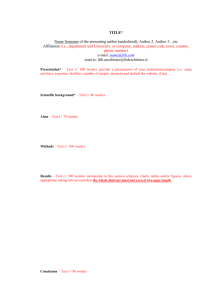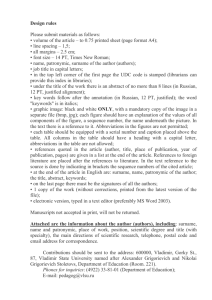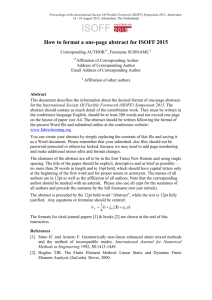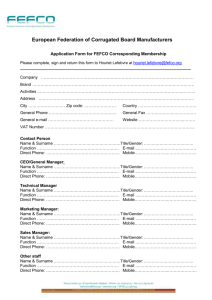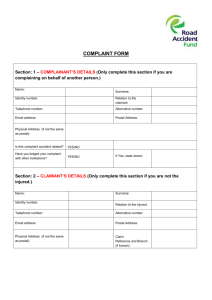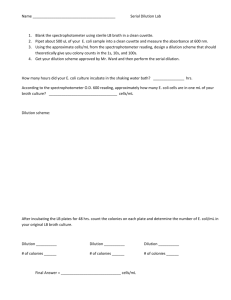Title of the paper should be informative but concise
advertisement
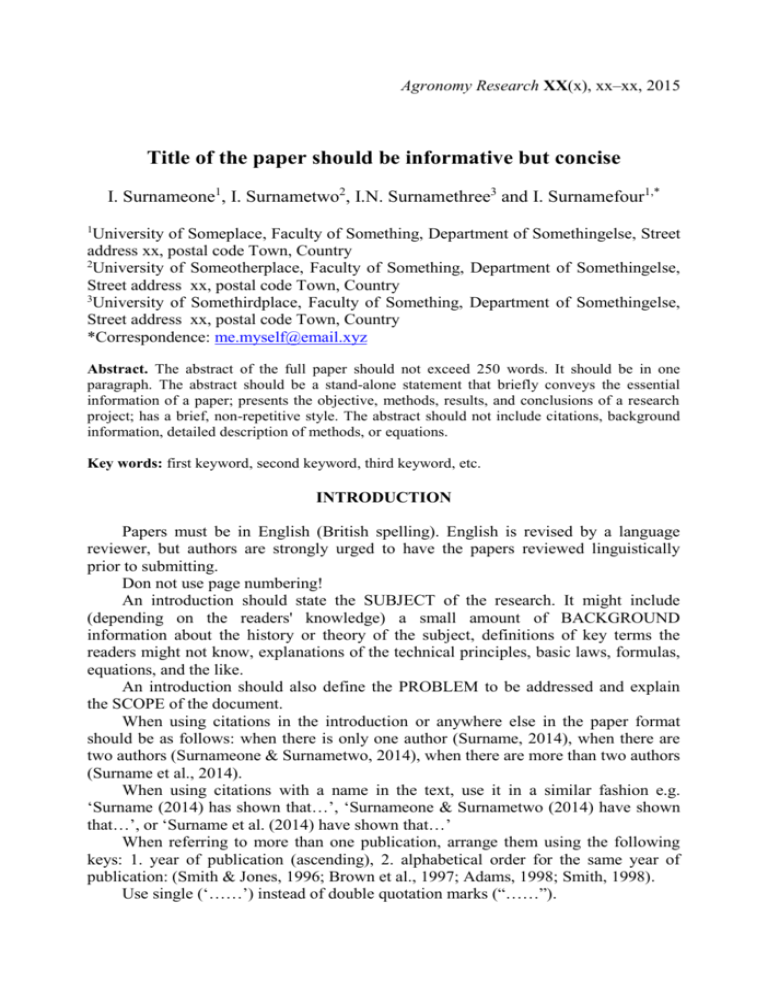
Agronomy Research XX(x), xx–xx, 2015 Title of the paper should be informative but concise I. Surnameone1, I. Surnametwo2, I.N. Surnamethree3 and I. Surnamefour1,* 1 University of Someplace, Faculty of Something, Department of Somethingelse, Street address xx, postal code Town, Country 2 University of Someotherplace, Faculty of Something, Department of Somethingelse, Street address xx, postal code Town, Country 3 University of Somethirdplace, Faculty of Something, Department of Somethingelse, Street address xx, postal code Town, Country *Correspondence: me.myself@email.xyz Abstract. The abstract of the full paper should not exceed 250 words. It should be in one paragraph. The abstract should be a stand-alone statement that briefly conveys the essential information of a paper; presents the objective, methods, results, and conclusions of a research project; has a brief, non-repetitive style. The abstract should not include citations, background information, detailed description of methods, or equations. Key words: first keyword, second keyword, third keyword, etc. INTRODUCTION Papers must be in English (British spelling). English is revised by a language reviewer, but authors are strongly urged to have the papers reviewed linguistically prior to submitting. Don not use page numbering! An introduction should state the SUBJECT of the research. It might include (depending on the readers' knowledge) a small amount of BACKGROUND information about the history or theory of the subject, definitions of key terms the readers might not know, explanations of the technical principles, basic laws, formulas, equations, and the like. An introduction should also define the PROBLEM to be addressed and explain the SCOPE of the document. When using citations in the introduction or anywhere else in the paper format should be as follows: when there is only one author (Surname, 2014), when there are two authors (Surnameone & Surnametwo, 2014), when there are more than two authors (Surname et al., 2014). When using citations with a name in the text, use it in a similar fashion e.g. ‘Surname (2014) has shown that…’, ‘Surnameone & Surnametwo (2014) have shown that…’, or ‘Surname et al. (2014) have shown that…’ When referring to more than one publication, arrange them using the following keys: 1. year of publication (ascending), 2. alphabetical order for the same year of publication: (Smith & Jones, 1996; Brown et al., 1997; Adams, 1998; Smith, 1998). Use single (‘……’) instead of double quotation marks (“……”). Use italics for Latin biological names and for statistical terms (t-test, n = 193, P > 0.05) MATERIALS AND METHODS Materials and Methods sections should include full description of all the materials, chemicals, instrumentation, and methodologies that were used in the work. All tables must be referred to in the text (Table 1; Tables 1, 2). All figures must be referred to in the text (Fig. 1; Fig. 1, a, b; Figs 1, 3; Figs 1–3). Use subdivisions when necessary Using subdivisions often helps to organize the content of your paper better. In Materials and Methods chapter the possible subdivisions could include: chemicals, solutions, materials, instrumentation, methods, software etc. Blank sample Transesterification Glycerol Washing Drying Process sample Day tank Storage Antioxidant Figure 1. Use schematics and figures that are clearly titled and labelled. Title of the figure is situated below the figure. Use font Arial within the figures. Use only black and white for figures. Figure 2. When using photographs as figures, make sure that they are viewable in black and white as well. Table 1. Tables should be clearly titled. Title of the table is situated above the table. Do not use vertical lines as dividers, only horizontal lines are allowed. Primary column and row headings should start with an initial capital, secondary headings without initial capital Veterinary Drug Carepen 1st dilution array 2nd dilution array to refine results 500 1,000 5,000 7,000 1,500 3,000 2,000 1,000* 2,500 3,000* Veterinary Drug Norocillin 1st dilution array 10 30 50 100 150 2nd dilution array to refine results 10* 15 20 25 30* 9,000 200 * - dilution was made as a control to ensure reliability of results Theory and modelling If your methodology chapter includes theoretical section or a mathematical model, you should use Microsoft office equation editor to formulate equations e.g. A 1 n ai n i 1 (1) where: n – data-set extent; ai – variable at the i index of a data-set, N. All equations should be clearly described with all variables and constants defined. RESULTS AND DISCUSSION In the “Results and discussion” section all pertinent results should be presented in a logical order and discussed. Discussion portion could also include significance of the results in context of the research field, and suggestions for the future research. Figure 3. All figures in the results section should be clearly titled and labelled. Within the figure use font “Arial”. Make sure the figure is undersandable in black and white. When presenting the numerical values of your results, use ‘.’ (not ‘,’) : 0.6 ± 0.2; use a ‘comma’ for thousands - 1,230.4 (one thousand two hundred and thirty and four tenths); use degrees and percentages without space: 5°C, 5% (not 5 °C, 5 %); use ‘–’ (not ‘-’) and without space: pp. 27–36, 1998–2000, 4–6 min, 3–5 kg; in case of other units use spaces: 5 h, 5 kg, 5 m, C : D = 0.6 ± 0.2; for complex units use ‘kg ha-1’ (not ‘kg/ha’); for degree use the symbol ‘ ° ’ not superscript o: 5°C (not 5oC). CONCLUSIONS The Conclusions should not just restate the main results but draw wider conclusions from the results. It may include bulleted items. Conclusions can also include assessment and suggestions. ACKNOWLEDGEMENTS. The acknowledgements should include all people, institutions and funds that have helped to achieve the goals of the research but have not been mentioned as authors. Logo of the funding organization can be included if necessary. REFERENCES European biodiesel board 2013. http://www.ebb-eu.org/stats.php. Accessed 7.2.2013. Noréus, O. & Trigell, A. 2008, Measurement of terrain values and drawbar pull for six wheeled vehicle on sand. In: 16th International Conference of the International Society for Terrain Vehicle Systems. ISTVS, Turin, pp. 250–257 (in Italy). Sloboda, A., Ferencey, V., Hlavňa, V. & Tkáč, Z. 2008. Construction of tyres and crawlers vehicles. Vienala, Košice, 552 pp. (in Slovak). STN 72 1010 The statement of soil bulk density. 1989. Šima, T., Nozdrovický, L., Dubeňová, M., Krištof, K. & Krupička, J. 2013. Effect of crop residues on nitrous oxide flux in the controlled traffic farming system during the soil tillage by LEMKEN Rubin 9 disc harrow. Agronomy Research 11, 103–110. For more information on the full paper format, please visit http://bse.emu.ee/Instructions.pdf.
